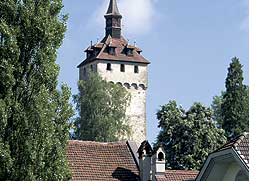Lucerne sightseeing

Lucerne has a vast number of monuments worthy of a sightseeing trip. This is a brief selection of sights you will not want to miss. Stroll through the narrow lanes of the city and discover your own favourites.

Chapel bridge
Constructed in first half of the 14th century as a part of the city's fortifications and named after St. Peter's Chapel, which is located nearby. The paintings that were added in the 17th century illustrate scenes of Swiss and local history, including the biographies of the city's patron saints, St. Leodegar and St. Maurice.

Water tower
This octagonal tower - over 34 meters high (111.5 ft.) - was built around 1300 as part of the city wall and used as an archive, treasury, prison and torture chamber. It is Lucerne's trademark and the most frequently photographed monument in Switzerland.

Jesuit church
The first large sacral Baroque church in Switzerland; constructed in 1666 by Father Christoph Vogler for the Jesuits. The vault was redecorated in the mid-18th century. The original vestments of Brother Klaus, a famous Swiss patron, are stored in the inner chapel.

Franciscan church
Typical medieval Gothic mendicant architecture; built in the second half of the 13th century. The church has the most ornate pulpit in Switzerland built between the Renaissance and Baroque eras. Flag frescoes represent Lucerne's conquests in the Middle Ages.

Water spike
Technically, this is a unique sight. The so-called "spikes" are lowered into or withdrawn from the water manually to regulate the water level of Lake Lucerne. It was built in 1859-60, replacing the Reuss steps that channeled the water over the city mills.

Spreuer bridge
This bridge was completed as a part of the city fortification in 1408. Between 1626 and 1635, Kaspar Meglinger added 67 paintings that represent the "Dance of Death". It is called the Spreuer Bridge because it was only here that chaffs of wheat (Spreu) could be dumped into the river.

Musegg wall
A part of the rampart walls built in 1386; the wall is still almost entirely intact. Three towers are open to the public: Schirmer, Zyt and Mannli. The oldest city clock, built by Hans Luter in 1535, is in the Zyt tower. This clock is allowed to chime every hour one minute before all the other city clocks.

Old sity squares
Historical buildings clad in frescos border the old city on the right bank of the River Reuss at a few picturesque squares. The Weinmarkt, where Lucerne swore a federal oath with the cantons of Uri, Schwyz and Unterwalden, is especially attractive. Equally attractive is the Hirschenplatz square, named after an old inn dating from the Middle Ages, and the Kornmarkt square, which features the Town Hall and the beautifully painted Pfistern guildhall.

Town hall
Built between 1602 and 1606 by Anton Isenmann in the Italian Renaissance style and covered with an overhanging roof as is typical for Bern. The open arcades facing the Reuss are still used today as a weekly marketplace. Above the arcades is the Kornschutte hall, an earlier trading goods store, which is now used as a concert and exhibition locale.

Hof church
Main cathedral for the city, as well as the St. Leodegar and St. Maurice religious center. A Benedictine monastery was founded here in the 8th century. In 1633, a fire destroyed the church; it was rebuilt in 1645. It is the most important Renaissance church in Switzerland. Especially noteworthy are the facade, Mary's alter (with a relief panel dating from 1500), and the souls' altar.

Lion monument
"The dying Lion of Lucerne" is one of the world's most famous monuments. It was carved out of natural rock in memory of the heroic deaths of the Swiss mercenaries at the Tuileries in 1792. Mark Twain described the Lion of Lucerne as "the saddest and most moving piece of rock in the world".

Ritterscher palace
Built in 1557 in the Italian Renaissance style for Lucerne’s mayor Lux Ritter as a private residence. The city later completed the building. Living quarters for the Jesuits who were called to Lucerne in 1574. Today it is the seat of the cantonal government.

Culture and Convention Center
The Lucerne Culture and Convention Center on Europa Square is the work of the Parisian architect Jean Nouvel. The concert hall (1800 seats) is one of the finest concert halls in the world. The Lucerne Hall, the Convention Center with the auditorium, and the Museum of Art - the fourth largest in Switzerland - are also part of this sensational construction.

Railway station
Following the fire in 1971, the entire railway station was rebuilt between 1984 and 1991. The transparent entrance hall of the new station, with its elegant curved roof, is architecturally unique. It was designed by Spanish architect Santiago Calatrava. The main portal of the old station, which survived the fire, now stands as an impressive arch in the middle of the square in front of the station.